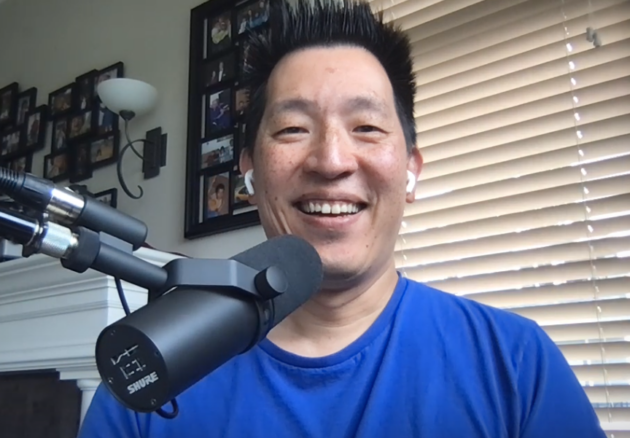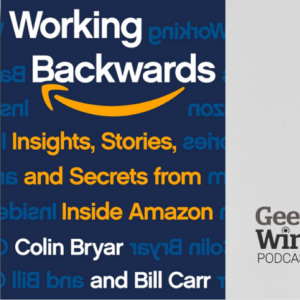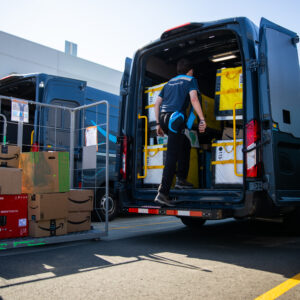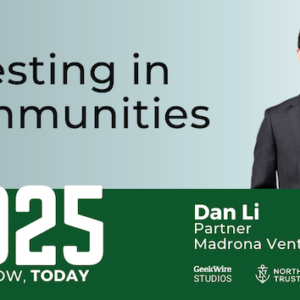
Philip Su, a software engineering leader turned non-profit founder, decided to shake up his life last fall — seeking an antidote to his seasonal depression in a job with more structure and less pay than he had experienced in many years.
Su worked the peak season at Amazon’s giant flagship warehouse south of Seattle, in Kent, Wash., known by the code name BFI4 inside the company. It was a life-changing and eye-opening experience, as Su documents in his 15-episode podcast series, Peak Salvation.
A former Microsoft software engineer who was the second employee at Facebook’s Seattle engineering office, Su led the London engineering office for Facebook (now Meta), then founded and ran the global health software nonprofit Audere before adding Amazon warehouse worker to his LinkedIn profile.
I listened to entire Peak Salvation podcast last weekend; the story really hooked me as it unfolded. Su does a great job explaining and analyzing his experience. I also invited him to join me on the GeekWire Podcast this week.
Here are a few things that stood out to me in his story.
- He found peace and stability in the structure, and the ability to leave work behind and out of mind when he clocked out.
- Getting hired online took him a couple minutes; quitting was easier than canceling a Netflix subscription.
- No one learned his name during his time at the Amazon warehouse. The operation seemed anonymous out of necessity due to turnover.
- Amazon’s injury reporting system left him with a choice between receiving significantly fewer hours and pay on light duty, or sticking with the job that caused the injury to continue getting his normal pay.
- The pay structure, as he viewed it, gave many employees little incentive to do more than the bare minimum.
Those are my takeaways. Su is upbeat about many aspects of his experience, including the way it benefited his mental health, and the new and humbling perspective it gave him on the privileged nature of life in the tech industry.
A newcomer to the front lines of global fulfillment, Su readily acknowledges that there could very well be good reasons for some of the quirks that he perceived as dysfunctions. Not only that, but he was a short-term worker, with a tenure of less than two months. He’s no logistics expert.
However, he brought fresh eyes and an engineer’s mind to the e-commerce giant’s operational nerve center. So we asked Su what changes he would make, based on his experience and observations, and he came up with this list.
- Move into Boeing’s three-shift model. Less bodily wear given 8-hour days instead of 10/11.5-hour days, and the ability to add temporary folks during Peak without requiring overtime.
- Build career paths. Jeff Bezos didn’t believe these jobs would/should ever be permanent, but Amazon’s now hiring 1 of every 153 working Americans, and it’s growing. Like it or not, these jobs will increasingly become long-term jobs for people. Give the best shifts and jobs to existing employees instead of offering them first to newcomers. Give paths for the best performers to be recognized and to rise.
- Increase scheduling predictability. Announce extra shifts 48 hours in advance; don’t fire people when they can’t do extra shifts.
- Alleviate physical toll proactively. Rotate people periodically amongst tasks requiring different muscles. Establish a fast, non-predatory medical accommodation system that serves employee interests. Take physical ability into account when assigning roles.
- Increase sense of ownership. Give employees the agency to suggest and be recognized for making improvements. I spotted many improvement opportunities but was only able to convince leads to barely implement one.
Another possibility that we discussed is the idea of Amazon bringing back stock grants for warehouse workers to address some of these issues. The company’s recent 20-for-1 stock split would seem to make this more feasible.
These are especially timely issues for Amazon given the recent news that Dave Clark, Amazon’s Worldwide Consumer CEO, is leaving with no immediate successor named. Amazon says it’s on a quest to become “Earth’s Best Employer,” amid a groundswell of union activity across the company’s fulfillment network.
All of these opportunities and challenges give Amazon CEO Andy Jassy an opening, perhaps, to try some different approaches in the company’s logistics network.
Philip Su joins this episode of the GeekWire Podcast to share what he learned about the nature of work, socioeconomic status, Amazon, and himself.
Listen above, or subscribe to GeekWire in Apple Podcasts, Google Podcasts, Spotify or wherever you listen.
Audio produced and edited by Curt Milton.





